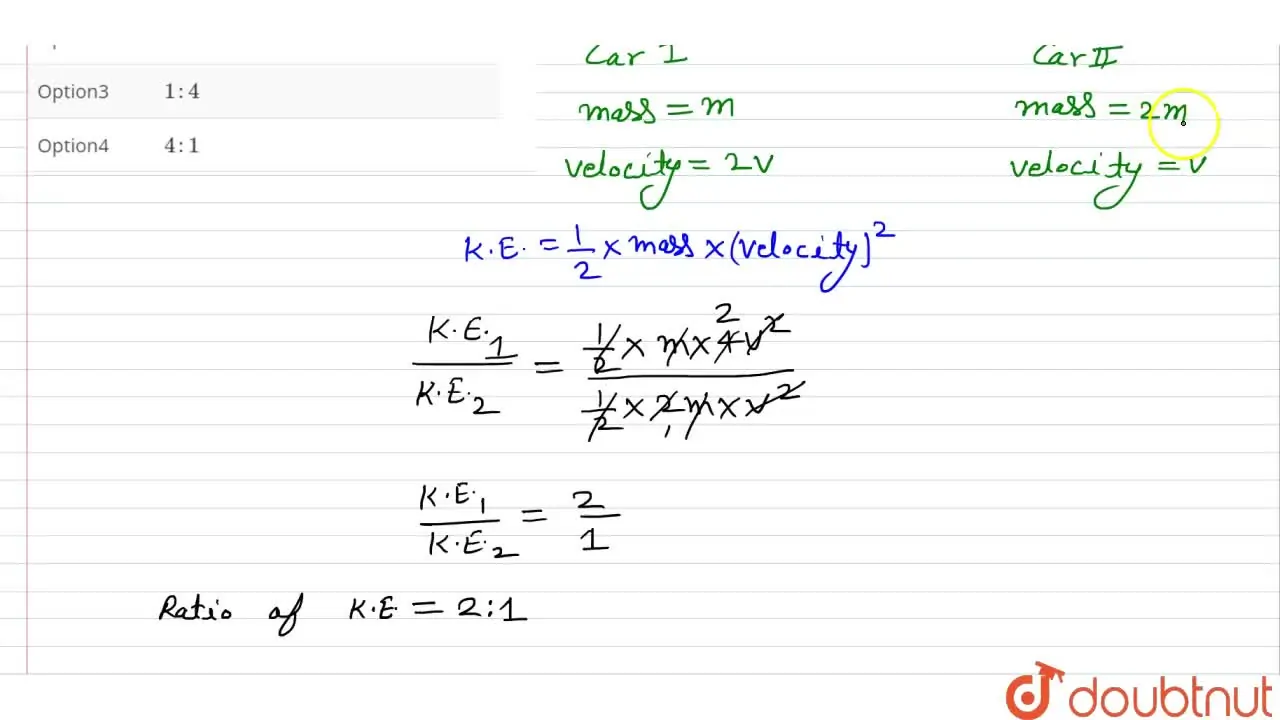Cars I and II, having masses m and 2m respectively, are moving with velocities
2v and v respectively. They are brought to rest by the application of breaks. The cars take the same time and cover the same distance before coming to rest.
What is the ratio of change in kinetic energy of car I to that of car II ?
1:2
2:1
1:4
4:1
Step by step video & image solution for Cars I and II, having masses m and 2m respectively, are moving with velocities 2v and v respectively. They are brought to rest by the application of breaks. The cars take the same time and cover the same distance before coming to rest. What is the ratio of change in kinetic energy of car I to that of car II ? by Physics experts to help you in doubts & scoring excellent marks in Class 6 exams.
Related Playlists
- BOOK - BEIITIANSCHAPTER - ENERGY AND WORK EXERCISE - IIT JEE WORKSHEET34videos
ENERGY AND WORK
- BOOK - BEIITIANSCHAPTER - ENERGY AND WORK EXERCISE - SUMMATIVE WORKSHEET35videos
ENERGY AND WORK
- BOOK - BEIITIANSCHAPTER - ELECTRICITY EXERCISE - IIT JEE Worksheet V. Matrix Matching2videos
ELECTRICITY
- BOOK - BEIITIANSCHAPTER - LIGHT EXERCISE - IIT JEE WORKSHEET1videos
LIGHT
Similar Questions
A motor cycle and a car are moving on a horizontal road with the same velocity. If they are brought to rest by the application of brakes, which provided equal retarding forces, then
View SolutionA truck and a car moving with the same KE are brought to rest by the application of brakes which provide equal retarding force. Which of them will come to rest in a shorter distance ?
View SolutionA lorry and a car moving with the same kinetic energy are brought to rest by the application of brakes which provides equal retarding forces. Which of them will come to rest in a shorter distance?
View SolutionA truck and a car moving with the same kinetic energy are brought to rest by the application of brakes which provide equal retarding forces. Which of them will come to rest in a shorter distance?
View SolutionTwo cars of same mass are moving with velocities v1andv2 respectively. If they are stopped by supplying same breaking power in time t1andt2 respectively then v1v2 is
View SolutionA lorry and a car, moving with the same kinetic energy are brought to rest by application of brakes which provied equal retarding forces. Which one of them will come to rest in a shorter distance ?
View SolutionTwo objects having same mass 'm' are moving with velocities v and 2v. Find ratio of their kinetic energies.
View SolutionThe speeds of three cars are in the ratio 4: 3: 2. What is the ratio between the times taken by the cars to cover the same distance ?
View SolutionA truck and a car are brought to a hault by application of same braking force. Which one will come to stop in a shorter distance if they are moving with same (a) velocity (b) kinetic energy and (c) momentum ?
View SolutionA truck covers a distance of 360 km in 8 hours . A car covers the same distance in 6 hours . What is the respective ratio between the speed of the truck and the car ?
View Solution


